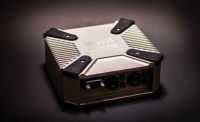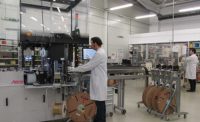The Industrial Internet of Things (IIoT) is perhaps the biggest buzzword in factory automation today, and it is a key aspect of Industry 4.0. But IIoT is more than just the way of the future. The IIoT is already affecting the way factories operate today, and it will increasingly impact businesses in the future. Therefore, it is essential to understand the terms being used, recognize how IIoT technologies are already being implemented in manufacturing facilities, and prepare your business for the future.
The term “Industry 4.0” broadly describes the current wave of technological innovation as an era in history characterized by interconnectivity enabled by the Internet and wirelessly connected devices. By way of background, Industry 1.0 refers to the era of water and steam power and Industry 2.0, the era of electric power. Industry 4.0 follows closely on the heels of the digital era (Industry 3.0), and many manufacturing facilities still operate using digital technologies. While digital technologies have enabled the collection of large amounts of valuable data, this data primarily exists in silos that are not easily accessible for analysis and actionable insights.
The technologies of Industry 4.0 take data collection to the next level by making data readily available and by automating the communication between industrial automation equipment and systems. This allows businesses to leverage data in more meaningful ways, including enabling predictive analysis for machines as well as process optimization across the factory floor.
While Industry 4.0 refers to a period of advancements in technology, the Internet of Things (IoT) describes the technologies that connect objects—from consumer electronics to industrial components—to the Internet. The IIoT refers specifically to the impact of this innovation on industrial applications. IoT and IIoT technologies together create “smart” networks. For example, the wireless technologies of a smart home connect homeowners to almost anything in the house—from their home security system to their refrigerator—and allow remote accessibility via smartphone. Similarly, a smart factory provides plant managers with visibility, analytics and remote access to wirelessly connected machines.
The key benefits of IIoT technologies for factory automation include:
- Visibility into the operational status of machine components (both historically and in real-time) allows plant managers to remotely monitor and diagnose systems quickly, as well as identify and resolve problems before the impact on machine availability and productivity compounds.
- Predictive analytics allows for more accurate planning of machine maintenance, which can help reduce machine downtime, increase mean time between failure (MTBF), and reduce costs of unnecessary preventative maintenance and spare parts inventory.
- Interconnectivity enables seamless communication among machines, components, and people. Interconnectivity increases efficiency by allowing for more autonomous machine performance and streamlined manual processes.
Overall, the increased visibility, analytics, and interconnectivity afforded by IIoT mean that these technologies are not just short-term investments or solutions to immediate problems. Rather, they enable continuous improvement by providing companies with the capabilities necessary to solve new problems as they arise—compounding the value of the investment over time.
IIoT technologies allow businesses to access and leverage factorywide data in more meaningful ways compared to digital technologies, but what does that look like in practice? The following are three practical examples of how visibility, predictive analytics, and interconnectivity are affecting factories today.
Visibility and Remote Access Increase Efficiency
To ensure efficient processes throughout the factory, machine operators must quickly and easily determine the status of machines. The greater the visibility, the easier it is to identify and resolve problems and keep operations running smoothly. Traditional tower lights provide visibility wherever they can be physically seen. However, tower lights equipped with wireless communication capabilities take visibility to the next level by both displaying a visual indication of an event and transmitting wireless alerts. This helps ensure that operational problems are identified and addressed immediately, regardless of whether a machine operator is physically present to see the visual indicator.
For example, tower lights with wireless communication allow operators to remotely monitor machine performance without lengthy and expensive cable runs. The lights indicate machine status visually while updates are also transmitted over a secure wireless network to a remote device, triggering an action or prompting a response from an operator at a workstation away from the machine.
An additional benefit of wireless indicators is data logging for use in overall equipment effectiveness (OEE) calculations. Not only can operators respond to alerts quickly as they occur, but a history of alerts can also be stored and analyzed offline. This historical data can be used to track machine uptime, production volume, rejected parts, and other key metrics to make more informed decisions over time.
Predictive Maintenance Increases Machine Uptime and Availability
In addition to real-time status monitoring, IIoT technologies can also be used to help avoid machine failures thanks to predictive maintenance. The traditional approach to machine maintenance is to follow a prescribed regimen of preventative maintenance. This involves regularly replacing machine components based on the manufacturer’s suggested timeline rather than data from the actual machine. This means that you might be paying too much for unnecessary preventative maintenance plans and replacement parts; or you might experience unexpected downtime if something goes wrong between scheduled maintenance visits.
With predictive maintenance, much of the guesswork is removed because maintenance decisions can be made based on the historical and real-time data from the machine itself. For example, wireless vibration and temperature sensors can detect signs of misaligned, loose or worn parts on a machine. The wireless sensors then transmit that information to a wireless controller that makes data available immediately (via text or email alerts) and for long term analysis.
By monitoring machine components in real-time for increases in vibration and temperature, problems can be detected and resolved before they become too severe and cause additional damage or result in unplanned downtime. Over time, the historical data creates a valuable machine performance log that can be used to make more informed maintenance decisions down the line.
Interconnectivity Streamlines Factory Communications
IIoT technologies are not just useful for optimizing machines. In fact, wireless technologies enable seamless interaction among human workers as well, and can have a significant impact on the efficiency of manual production lines. For example, instead of requiring machine operators to walk over to the manager area for assistance with a technical issue, a wireless system using connected pushbuttons or switches and tower lights can be used to alert managers when assistance is needed on the line.
For example, a notification system might be set up so that an operator pushes a button or flips a switch to alert the manager or technician that he or she is needed on the production line. A tower light connected to the gateway’s outputs would then indicate which production line needs a manager’s attention, and colors could be assigned to indicate the need for a technician (red) or manager (yellow). Wireless pushbuttons equipped with LED status lights can also facilitate two-way communication by configuring the LED to change color when the manager or technician indicates that he or she is on their way.
Using a wireless tower light notification system reduces the need for technicians and managers to constantly check each production line and for workers to leave their workstations when they need assistance. By utilizing a wireless network of connected devices to streamline communications, managers, technicians, and line workers are able to use their time more efficiently and productively.
Conclusion: Is Your Business IIoT-Ready?
From keeping machines running smoothly to enabling seamless communication between machines, components and people, the benefits of IIoT technologies are tangible. However, it can be challenging knowing where to start and how to use these technologies to their fullest advantage.
Below are three questions to help manufacturers prepare for a move from digital to IIoT:
- What are the inefficiencies in your operations?
- What kind of data would help you overcome these inefficiencies?
- What communication processes need to be in place to use data in a meaningful way?
Answering these questions can help manufacturing facilities identify the best technologies to meet their immediate business needs and start taking advantage of the long-term benefits of IIoT.
ASSEMBLY ONLINE
For more information on Industry 4.0 and IIoT, visit www.assemblymag.com to read these articles:
- Industry 4.0: Myths vs. Reality.
- Faurecia’s Factory of the Future.
- German Factory Implements “Industry 4.0.”




